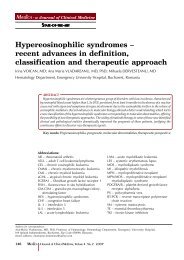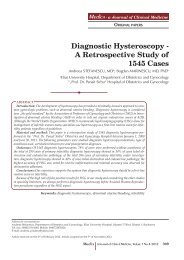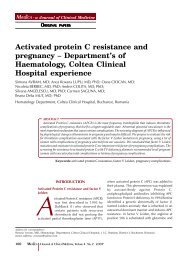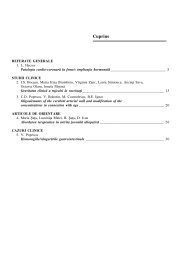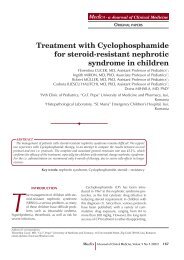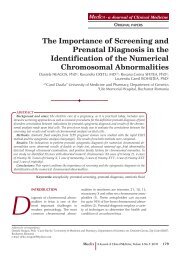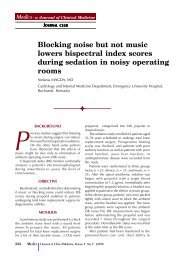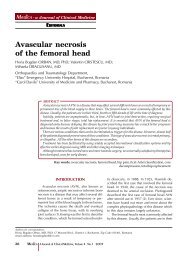Early Repolarization Syndrome - MÃDICA - a Journal of Clinical ...
Early Repolarization Syndrome - MÃDICA - a Journal of Clinical ...
Early Repolarization Syndrome - MÃDICA - a Journal of Clinical ...
You also want an ePaper? Increase the reach of your titles
YUMPU automatically turns print PDFs into web optimized ePapers that Google loves.
EARLY REPOLARIZATION SYNDROME- TO BE OR NOT TO BE BENIGN<br />
studies, as in vivo studies are limited by anesthetic<br />
use. Ventricular repolarization occurs<br />
when depolarization ends, the transition from<br />
the latter (J point on ECG) lasting less than 10<br />
miliseconds; any factor interfering with excitation<br />
wave propagation or cellular excitability<br />
recovery reduces or increases duration. Many<br />
electrophysiological studies have identified the<br />
voltage-gated inward and outward currents involved<br />
in repolarization: Ca, Na, Cl and most<br />
important K currents. Numerous types <strong>of</strong> channels<br />
modulate these currents, changes in their<br />
dispersion or structure directly influencing repolarization.<br />
For example long QT syndrome<br />
or Brugada syndrome underlying causes are represented<br />
by genetic changes in ion channels<br />
structure and consecutively function. The relatively<br />
small currents that determine the plateau<br />
phase <strong>of</strong> action potential alterations induce<br />
ma jor changes in repolarization process. What<br />
is to be remembered in order to better understand<br />
ERS, is the fact that experimental studies<br />
have demonstrated that functional expression<br />
<strong>of</strong> ion channels in ventricles changes during<br />
nor mal development <strong>of</strong> the heart as well as in<br />
va rios pathological or non pathological situations<br />
that influence cardiac activity. Little is known<br />
about the underlying mechanism (5).<br />
J point elevation and ST segment elevation<br />
are the key features <strong>of</strong> ERS. ST segment corresponds<br />
temporally to plateau phase, the normal<br />
ECG ST segment aspect indicating the absence<br />
<strong>of</strong> a significant voltage gradient during<br />
ven tricular repolarization (5). Pathological ST<br />
ele vation is a marker <strong>of</strong> myocardial injury, as a<br />
re sult <strong>of</strong> voltage gradient among different myocardial<br />
layers due to ischemia, but this is not<br />
the case in a normal heart.<br />
The most discussed hypothesis incriminates<br />
a voltage gradient across the ventricular wall<br />
during repolarization generated by Ito channels<br />
heterogeneity (Ito current is the most important<br />
determinant <strong>of</strong> ST segment behavior). The difference<br />
in Ito-mediated action potential spike<br />
and dome between ventricular epicardium and<br />
endocardium produces a transmural voltage<br />
gra dient during early repolarization that may<br />
generate J wave elevation. Another opinion regarding<br />
the underlying mechanism speculates<br />
involvement <strong>of</strong> localized depolarization abnormalities<br />
with repolarization anomalies derived<br />
from the first (as in type 1 Brugada syndrome).<br />
Nevertheless there is a possibility that both mechanisms<br />
are responsible for ERS, but further<br />
information is required based on molecular<br />
techniques, morphologic imaging, voltage map<br />
p ing, genetic pr<strong>of</strong>iling in familial cases, autopsy<br />
studies <strong>of</strong> the ventricular area corresponding<br />
to the electrocardiographic changes.<br />
Ge ne tic changes in ionic channel properties<br />
were incriminated, but no sustained genetic<br />
pro filing was ever performed. Recently a mutation<br />
<strong>of</strong> gene KCNJ8 responsible for the porefor<br />
ming subunit Kir6.1 <strong>of</strong> the IK ATP<br />
channel was<br />
identified in individuals with idiopathic ventricular<br />
fibrillation (2, 4, 6, 7). Other possible<br />
explanations are related to anatomic nervous<br />
system disturbances in favor <strong>of</strong> vagotonia and<br />
acceleration <strong>of</strong> conduction in cardiac by pass<br />
tracts (4).<br />
Often misdiagnosed as myocardial infarction,<br />
pericarditis or other diseases that involve<br />
ST segment elevation, ERS was considered as<br />
not having any clinical implication, until several<br />
clinical population studies “cast a spell” on its<br />
innocence. Experimental studies, case reports<br />
and clinical studies have shown ERS potential<br />
arrhythmogenic effect. In 2000, based on preclinical<br />
experimental work, Antzelevitch suggested<br />
that ERS should not be considered as<br />
normal or benign ECG abnormality, unless otherwise<br />
proven, as under certain conditions<br />
known to predispose to ST-segment elevation,<br />
pa tients with ERS may be at higher arrhythmogenic<br />
risk (4).<br />
Until 2008 most <strong>of</strong> the clinical data came<br />
from case reports primarily involving Asian individuals<br />
with idiopathic arrhythmia and ERS.<br />
In 2008, Haissaguerre et al. reported higher<br />
incidence <strong>of</strong> recurrent ventricular fibrillation in<br />
subjects with repolarization abnormality than<br />
in those without by reviewing data <strong>of</strong> 206 subjects<br />
resuscitated after cardiac arrest due to idiopathic<br />
ventricular fibrillation. Data was collected<br />
from centers in 22 countries, subjects<br />
less than 60 years were enrolled (for avoiding<br />
higher incidence <strong>of</strong> cardiac structural disease)<br />
and was compared to that <strong>of</strong> a control group<br />
(412 subjects matched as age, sex, race and<br />
phy sical activity). Information about history <strong>of</strong><br />
syn cope (personal and familial), level <strong>of</strong> physical<br />
activity, results on signal-averaged electrocardiography<br />
and pharmacological testing (at<br />
baseline, 6 and 12 months) was corroborated<br />
with results on electrophysiological testing with<br />
the use <strong>of</strong> multielectrode catheters. ERS occurred<br />
in 64 case subjects 31%, <strong>of</strong> case subject as<br />
compared with 5%, control subjects (p




